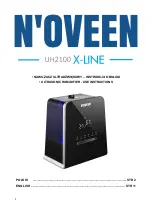
2
EGW06-PCPEG-20140813
TM
TM
However, increasing ventilation rates can significantly add to the cost of operation. Including energy conservation
strategies such as heat recovery, airflow measurement and CO2 based control help control costs while improving indoor
air quality.
Depending on the geographic location and season of the year, treating the outside air has a direct effect on energy
consumption. Some facilities prefer higher than minimum ventilation rates, up to 100% of OA, to maximize indoor air
quality, but the cost of treating this air can be significant.
OCCUPANT COMFORT
Occupant comfort in a natatorium is easy to understand. If you ever swam in an outdoor pool on a cold, windy day,
or exited a pool in a dry, desert location--you will probably notice an immediate chill. The opposite is true where
high humidity is not adequately controlled either through ventilation or by mechanical means. The moisture level can
reach such a state where it is oppressive or stuffy. Common complaints are difficulty in breathing and the room being
perceived to be warmer than the actual dry bulb temperature would suggest.
Regardless of the source of discomfort, users will not enjoy the facility if water/air temperatures and humidity levels are
not within a narrow range. Ideal water temperature is around 82° with the air temperature about 2 degrees F higher to
prevent chilling when exiting the pool and to minimize evaporation from the pool surface. Here are some recommended
temperatures for poolrooms, which can be adjusted to meet specific needs of bathers. In general, “active” poolrooms are
maintained at lower temperature ranges so the users don’t overheat, warmer temperatures are more common for seniors
or children or less active pools.
The desirable humidity range is generally between 50% and 60%--greater than 60% creates a sticky feeling and/or
difficult breathing, and low humidity results in evaporative cooling on the bather’s skin, resulting in a chill.
Poor air movement caused by improper duct placement within the poolroom will also lead to occupant discomfort.
Excessive supply air blowing on bathers can create drafts, while uneven air distribution may create stagnant zones within
the space.
Table 1-1. Typical Pool Water & Air Temperature Set-Points
POOL WATER CHEMISTRY
Water chemistry in swimming pools is critical for the health of the bathers and the condition of the enclosure and
components. An enclosure with poor water chemistry has a noticeable “chlorine” smell, which is an indication of high
chloramines in the air. Not only does this have an effect on the water, but it affects the bathers and the air they breathe.
Dehumidification systems are not designed to remove the effects of incorrect pool water chemistry. Dehumidification/
ventilation equipment is not designed to remedy the effects of poor pool chemistry, but is designed to deliver prescribed
ventilation to manage smaller amounts of pollutants generated from normal pool activity. Pool water chemistry is a part
of daily maintenance and it is recommended that the users follow the current National Spa and Pool Institute standards.
publication in the online PoolPak™ Educational Library.
Section I: Indoor Pool Design
Typical Pool Water & Air Temperature Set-Points
Pool Type
Water Temp. °F
Air Temp. °F
Room RH %
Recreational Pools
80-85
Water Temp + 2
55-60
Therapy Pools
86-92
86
1
55-60
Whirlpools
99-104
86
1
55-60
1
Normally max 86°F to minimize overheating of occupants








































